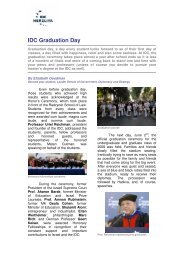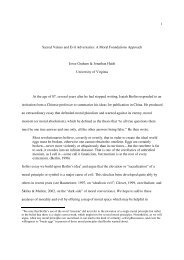Empathy-Induced Altruistic Motivation C. Daniel Batson
Empathy-Induced Altruistic Motivation C. Daniel Batson
Empathy-Induced Altruistic Motivation C. Daniel Batson
Create successful ePaper yourself
Turn your PDF publications into a flip-book with our unique Google optimized e-Paper software.
Running head: EMAPTHY-INDUCED ALTRUISM<br />
<strong>Empathy</strong>-<strong>Induced</strong> <strong>Altruistic</strong> <strong>Motivation</strong><br />
C. <strong>Daniel</strong> <strong>Batson</strong><br />
Department of Psychology<br />
University of Kansas<br />
Draft of lecture/chapter for Inaugural Herzliya Symposium on “Prosocial Motives,<br />
Emotions, and Behavior,” March 24-27, 2008.
<strong>Empathy</strong>-<strong>Induced</strong> <strong>Altruistic</strong> <strong>Motivation</strong><br />
<strong>Empathy</strong>-induced altruism 2<br />
About 30 years ago, I began conducting research on the motivational repertoire of<br />
humans. Specifically, I was interested in motivation for helping. I wanted to know whether<br />
when we help others our motivation is always and exclusively self-interested—universal<br />
egoism—or whether we are capable of being altruistically motivated as well.<br />
To be honest, I started with a clear bias. I thought altruism was a myth. In the words<br />
of the wise and witty Duke de la Rouchefoucauld: “The most disinterested love is, after all,<br />
but a kind of bargain, in which the dear love of our own selves always proposes to be the<br />
gainer some way or other” (Maxim 82, 1691). Bernard Mandeville (1714-1732) put it even<br />
more graphically:<br />
There is no merit in saving an innocent babe ready to drop into the fire. The action is<br />
neither good nor bad, and what benefit soever the infant received, we only obliged our<br />
selves, for to have seen it fall, and not strove to hinder it, would have caused a pain,<br />
which self-preservation compelled us to prevent. . . . (p. 42)<br />
Like La Rouchefoucauld and Mandeville, I assumed that everything we humans do, no matter<br />
how beneficial to others, is really directed toward the ultimate goal of one or more forms of<br />
self-benefit. But over the years, I have come to believe this assumption was wrong.<br />
What caused me to lose my faith in universal egoism? My downfall was a series of<br />
experiments that colleagues and I conducted to test the empathy-altruism hypothesis. Before I<br />
consider that line of research, let me back up and state explicitly what I mean by altruism.<br />
Depending on how altruism is defined, the question of its existence can be either quite<br />
profound or quite trivial. I hope my definition does not make the question trivial.
Defining Altruism and Egoism<br />
<strong>Empathy</strong>-induced altruism 3<br />
By altruism I mean a motivational state with the ultimate goal of increasing another’s<br />
welfare. Altruism is juxtaposed to egoism, a motivational state with the ultimate goal of<br />
increasing one’s own welfare. I use the term “ultimate” here to refer to means-end relations,<br />
not to a metaphysical first or final cause. An ultimate goal is an end in itself. In contrast, an<br />
instrumental goal is a stepping stone on the way to reaching an ultimate goal. If a barrier to<br />
reaching an instrumental goal arises, then alternative routes to the ultimate goal will be<br />
sought. Should the ultimate goal be reached bypassing the instrumental goal, the motivational<br />
force will disappear. If a goal is ultimate, it cannot be bypassed in this way (Lewin, 1938).<br />
Both instrumental and ultimate goals should be distinguished from unintended consequences,<br />
results of an action—foreseen or unforeseen—that are not the goal of the action. Each<br />
ultimate goal defines a distinct goal-directed motive. Hence, altruism and egoism are distinct<br />
motives, even though they can co-occur.<br />
Altruism and egoism, as defined, have much in common. Each refers to a<br />
motivational state; each is concerned with the ultimate goal of this motivational state; and, for<br />
each, the ultimate goal is to increase someone’s welfare. These common features provide the<br />
context for highlighting the crucial difference: whose welfare is the ultimate goal. Is it<br />
another person’s or one’s own?<br />
The term altruism has been used in three other ways from which the present<br />
conception should be distinguished.<br />
1. As helping behavior, not motivation. Some scholars set aside the issue of<br />
motivation, simply equating altruism with helping behavior (i.e., with acting in a way that<br />
benefits another). This definition has been common among developmental psychologists. It
<strong>Empathy</strong>-induced altruism 4<br />
has also been common among evolutionary biologists, who have defined altruism as behavior<br />
that reduces an organism’s reproductive fitness—the potential to put its genes in the next<br />
generation—relative to the reproductive fitness of one or more other organisms. Using this<br />
definition, evolutionary biologists can speak of altruism across a very broad phylogenetic<br />
spectrum, ranging from social insects to humans (Alexander, 1987; Dawkins, 1976; Hamilton,<br />
1964; Trivers, 1971; Wilson, 1975). However, as Sober and Wilson (1998) have pointed out,<br />
it is important to distinguish between evolutionary altruism and psychological altruism.<br />
Evolutionary altruism is behavior that reduces one’s reproductive fitness. Psychological<br />
altruism is motivation with the ultimate goal of increasing another’s welfare. Sober and<br />
Wilson emphasize that there is no necessary connection between these two concepts.<br />
Evolutionary altruism is neither necessary nor sufficient to produce psychological altruism. I<br />
hope it is clear that my interest is in psychological altruism.<br />
2. As acting morally. A second use of the term altruism focuses on a specific set of<br />
helpful acts—those that meet some standard of goodness or morality. The link between<br />
altruism and morality appears to be based on the juxtaposition of each to self-interest. Self-<br />
interest is often equated with selfishness, which is in turn often considered the epitome of<br />
immorality. Altruism involves other-interest rather than self-interest. It may seem that if self-<br />
interest is not moral, and altruism is not self-interest, then altruism is moral. But this logic is<br />
flawed. Quite apart from whether self-interest should be equated with immorality—Rawls<br />
(1971) and many others have challenged this equation—to say that A (altruism) is not B (self-<br />
interest) and B is not C (moral) does not imply that A is C. <strong>Altruistic</strong> motivation as I have<br />
defined it can produce behavior that, depending on the moral standard applied, is moral,
<strong>Empathy</strong>-induced altruism 5<br />
amoral, or immoral. Similarly, egoistic motivation can produce behavior that is moral,<br />
amoral, or immoral.<br />
3. As helping in order to gain internal rather than external rewards. A third use of<br />
altruism does consider the motivation for benefiting others. But, rather than treating altruistic<br />
motivation as an alternative to egoistic motivation, the third use reduces altruism to a special<br />
form of egoism. This use, quite common among contemporary psychologists, defines<br />
altruism in a way that includes benefiting another as a means to benefit oneself, as long as the<br />
self-benefits are internally rather than externally administered. According to this definition, if<br />
you help in order to gain a good feeling, to avoid guilt, or to reduce your aversive arousal<br />
caused by witnessing another’s suffering, then your motivation is altruistic. By my definition,<br />
these ultimate goals simply define relatively subtle forms of egoism.<br />
Why Worry About <strong>Motivation</strong>?<br />
Having offered my definition of altruism, it is time to face a pragmatic question: As<br />
long as a person in need is helped, why worry about the nature of the underlying motivation?<br />
The answer depends on one’s interest. If one is only interested in getting help for this person<br />
in this situation, the nature of the motivation may not matter. If, however, one is interested in<br />
knowing more generally when and where help can be expected, and how effective it is likely<br />
to be—perhaps with an eye to creating a more caring society—then understanding the<br />
underlying motivation is crucial. Behavior is highly variable. Occurrence of a particular<br />
behavior, including helping, depends on the strength of the motive or motives that might<br />
evoke that behavior, as well as on (a) the strength of competing motives if any, (b) how the<br />
behavior relates to each of these motives, and (c) other behavioral options available in the<br />
situation at the time. It also depends on whether the behavior promotes an instrumental or an
<strong>Empathy</strong>-induced altruism 6<br />
ultimate goal. The more directly a behavior promotes an ultimate goal, and the more uniquely<br />
it does so among the behavioral options available, the more likely the behavior is to occur.<br />
Behavior that promotes an instrumental goal can easily change if the causal association<br />
between the instrumental and ultimate goal changes, or if behavioral pathways to the ultimate<br />
goal arise that bypass the instrumental goal. Lewin (1951) argued that invariance (and<br />
explanatory stability) is found not in behavior or consequences, but in the link of a given<br />
motive to its ultimate goal.<br />
A Failed Philosophical Finesse<br />
It is also time for a little philosophical brush clearing. One frequently heard argument<br />
against the existence of altruism attempts to rule out its existence on logical rather than<br />
empirical grounds. The argument goes as follows: Even if it were possible for a person to<br />
have another’s welfare as an ultimate goal, such a person would be interested in attaining this<br />
goal and would experience pleasure on doing so; therefore, even this apparent altruism would<br />
actually be a product of egoism.<br />
Philosophers have shown that this argument, which invokes the general principle of<br />
psychological hedonism, fails because it confuses two different meanings of self and two<br />
different forms of hedonism. Concerning self, the meaning at issue for altruism is not self as<br />
agent (Who has the goal?) but self—and other—as object (Whose welfare is the goal?).<br />
Concerning hedonism, there are strong and weak forms. The strong form of psychological<br />
hedonism asserts that attainment of personal pleasure is always the goal of human action. The<br />
weak form asserts only that goal attainment always brings pleasure. The weak form is not<br />
inconsistent with the possibility that an ultimate goal of some action is to benefit another.<br />
Pleasure obtained can be a consequence of reaching this goal without being the goal. The
<strong>Empathy</strong>-induced altruism 7<br />
strong form of psychological hedonism is inconsistent with the possibility of altruism. But to<br />
affirm the strong form is simply to assert that altruistic motivation does not exist, not that it<br />
logically cannot exist. This affirmation is about empirical matters of fact that may or may not<br />
be true. (MacIntyre, 1967, reviews these philosophical arguments.) One can accept the weak<br />
form of psychological hedonism, as I do, and still entertain the existence of a motivational<br />
state with the ultimate goal of increasing another’s welfare (i.e., altruistic motivation).<br />
The Research Problem<br />
Given my definitions of altruism and egoism, helping another person—even at great<br />
cost to self—may be altruistically motivated, egoistically motivated, or both. To know which<br />
it is, we must determine whether benefit to the other is (a) an ultimate goal and any self-<br />
benefits are unintended consequences (altruism) or (b) an instrumental means to reach the<br />
ultimate goal of benefiting oneself (egoism).<br />
If helping benefits both a person in need and the helper, as it often does, how are we to<br />
know which is the ultimate goal? This puzzle has led many scientists to give up on the<br />
question of the existence of altruism, concluding that it cannot be answered empirically—and<br />
often adding that motivation does not really matter anyway (e.g., de Waal, 2008). I think their<br />
surrender is premature. I think we can empirically discern people’s ultimate goals. Indeed,<br />
we do it all the time. We do it when we infer whether a student is really interested or only<br />
seeking a better grade (What happens to the student’s interest after the grades are turned in?),<br />
why a friend chose one job over another, and whether politicians mean what they say or are<br />
only after votes. We also do it when someone does us a favor or is kind.<br />
Four principles are important when attempting to discern a person’s ultimate goal. (a)<br />
We cannot trust self-reports. People often do not know—or will not tell—their ultimate
<strong>Empathy</strong>-induced altruism 8<br />
goals. (b) We do not observe goals or intentions directly; we infer them from behavior. (c) If<br />
we observe a behavior that has two potential ultimate goals, the true ultimate goal cannot be<br />
discerned. It is like having one equation with two unknowns. However, (d) if we change the<br />
situation so that this behavior is no longer the best route to one of these goals, and we still<br />
observe the behavior, then that goal is not ultimate. We can cross it off the list of possible<br />
ultimate goals.<br />
These principles suggest a strategy to test for the existence of altruistic motivation for<br />
helping. First, we need to identify a likely source of altruistic motivation to help. Second, we<br />
need to identify plausible egoistic ultimate goals of motivation from this source. Third, we<br />
need to vary the situation so that either the altruistic goal or one or more of the egoistic goals<br />
can be better reached without having to help. Finally, we need to see whether this variation<br />
reduces helping. If it does, this goal may be ultimate. If it does not, we can cross this goal off<br />
the list.<br />
The <strong>Empathy</strong>-Altruism Hypothesis and Its Egoistic Alternatives<br />
Over the past 30 years, other social psychologists and I have used this general strategy<br />
to address the question of the existence of altruism in humans. The likely source of altruistic<br />
motivation that we have considered is empathic concern. By empathic concern I mean an<br />
other-oriented emotional response elicited by and congruent with the perceived welfare of<br />
someone in need. Empathic concern is other-oriented in that it involves feeling for the other.<br />
It includes feelings of sympathy, compassion, tenderness, and the like. This other-oriented<br />
emotion has been named as a source—if not the source—of altruism by Thomas Aquinas,<br />
David Hume, Adam Smith, Charles Darwin, Herbert Spencer, William McDougall, and<br />
several contemporary psychologists. Empathic concern should not be confused with the
<strong>Empathy</strong>-induced altruism 9<br />
cognitive ability to correctly perceive another person’s internal state—sometimes referred to<br />
as empathic accuracy (Ickes, 1993)—or with feeling as another person feels—referred to as<br />
empathy, emotional contagion, or affective resonance (de Waal, 2008; Hatfield, Caccioppo &<br />
Rapson, 1994).<br />
Considerable evidence supports the idea that empathic concern motivates helping<br />
directed toward reducing the empathy-inducing need (Coke, <strong>Batson</strong>, & McDavis, 1978;<br />
Dovidio, Allen, & Schroeder, 1990; Krebs, 1975; see <strong>Batson</strong>, 1991; Eisenberg & Miller,<br />
1987, for reviews). However, evidence of increased motivation to help tells us nothing about<br />
the nature of that motivation. Relieving the other person’s need could be (a) an ultimate goal<br />
producing self-benefits as unintended consequences, (b) an instrumental goal on the way to<br />
the ultimate goal of gaining one or more self-benefits, or (c) both. That is, the motivation<br />
could be altruistic, egoistic, or both.<br />
The empathy-altruism hypothesis claims that empathic concern felt for a person in<br />
need produces altruistic motivation to relieve that need. But three possible self-benefits of<br />
empathy-induced helping have been identified, producing three egoistic alternatives: (a)<br />
aversive-arousal reduction—reducing the empathic concern caused by witnessing another in<br />
need; (b) punishment avoidance—avoiding empathy-specific material, social, and self-<br />
punishments; and (c) reward seeking—gaining empathy-specific material, social, and self-<br />
rewards. Advocates of the empathy-altruism hypothesis do not deny that relieving the<br />
empathy-inducing need is likely to enable the helper to reduce aversive arousal, avoid<br />
punishments, and gain rewards. However, they claim that these benefits to self are not the<br />
ultimate goal of empathy-induced helping, only unintended consequences. Advocates of the
<strong>Empathy</strong>-induced altruism 10<br />
egoistic alternatives disagree. They claim that one or more of these self-benefits is the<br />
ultimate goal of the motivation to help produced by empathic concern.<br />
Experimental Designs to Test the <strong>Empathy</strong>-Altruism Hypothesis<br />
Against the Egoistic Alternatives<br />
Pursuing the strategy outlined above, colleagues and I have conducted a series of<br />
experiments to test the empathy-altruism hypothesis against one or more of these three<br />
egoistic alternatives. Typically, although not always, we provide research participants with an<br />
opportunity to help a person in need. We manipulate both the level of empathic concern felt<br />
for that person and some cross-cutting variable that changes whether helping is the most<br />
effective means (a) to reach the altruistic ultimate goal of removing the other’s need or (b) to<br />
reach one or more of the possible egoistic ultimate goals. Table 1 lists the cross-cutting<br />
variables we have used. These variables do not change the goal(s); they change the<br />
attractiveness or availability of behavioral routes to the different goal(s). As a result, each<br />
variable listed in Table 1 allows us to make competing empirical predictions from the<br />
empathy-altruism hypothesis and at least one of the egoistic alternatives.<br />
Not surprisingly, none of the proposed cross-cutting variables listed in Table 1 allows<br />
a clear test of the empathy-altruism hypothesis against all three egoistic alternatives because<br />
the alternatives involve quite different psychological processes. As a result, it is necessary<br />
either to conduct an experiment in which several cross-cutting variables are manipulated at<br />
once—which seems unwieldy and unwise—or to conduct a series of experiments in which the<br />
egoistic alternatives are tested one after another. Following the latter strategy, care must be<br />
taken when moving from testing one egoistic alternative to testing another. Experimental<br />
situations must remain comparable so that cumulative comparisons can be made. The best
<strong>Empathy</strong>-induced altruism 11<br />
way to maintain comparability is to use the same need situations, the same techniques for<br />
manipulating empathy, and the same dependent measures, changing only the cross-cutting<br />
variables. It is also important to test any given alternative in multiple experiments using<br />
different need situations, different techniques for inducing empathic concern, and if possible,<br />
different cross-cutting variables.<br />
Current Status of the <strong>Empathy</strong>-Altruism Hypothesis<br />
Reports have been published of more than 30 experiments in which one of the cross-<br />
cutting variables in Table 1 has been manipulated and empathy for a person in need has been<br />
either manipulated, measured, or both (see <strong>Batson</strong>, 1991, for a review of over 20; <strong>Batson</strong>, in<br />
preparation, provides a more complete review). Cumulatively, these experiments have tested<br />
all of the competing predictions in Table 1. To cite but one example of research using each<br />
cross-cutting variable, (a) viability of escape was manipulated by <strong>Batson</strong>, Duncan, Ackerman,<br />
Buckley, and Birch (1981); (b) necessity of one’s helping being effective was manipulated by<br />
<strong>Batson</strong> and Weeks (1996); (c) acceptability of other helpers was manipulated by <strong>Batson</strong>,<br />
Dyck, Brandt, <strong>Batson</strong>, Powell, McMaster, and Griffitt (1988, Study 1); (d) need for rewards<br />
of helping was manipulated by <strong>Batson</strong>, <strong>Batson</strong>, Griffitt, Barrientos, Brandt, Sprengelmeyer,<br />
and Bayly (1989); and (e) salient cognitions were measured by <strong>Batson</strong> et al. (1988, Study 5).<br />
Overall, results of these experiments have consistently patterned as predicted by the<br />
empathy-altruism hypothesis; results have failed to support any of the egoistic alternatives.<br />
To the best of my knowledge, there is at present no plausible egoistic explanation of the<br />
cumulative evidence from these experiments. This evidence has led me to conclude—<br />
tentatively—that the empathy-altruism hypothesis is true, that empathic concern produces<br />
altruistic motivation.
<strong>Empathy</strong>-induced altruism 12<br />
After reviewing the empathy-altruism research, as well as recent literature in<br />
sociology, economics, political science, and biology, Piliavin and Charng (1990) reached a<br />
similar conclusion:<br />
There appears to be a “paradigm shift” away from the earlier position that behavior<br />
that appears to be altruistic must, under closer scrutiny, be revealed as reflecting<br />
egoistic motives. Rather, theory and data now being advanced are more compatible<br />
with the view that true altruism—acting with the goal of benefiting another—does<br />
exist and is a part of human nature. (p. 27)<br />
However, in apparent contradiction to this conclusion, Maner, Luce, Neuberg, Cialdini,<br />
Brown, and Sagarin (2002) claimed to provide evidence that once the effects of negative<br />
affect are removed, there is no longer a positive relation between empathic concern and<br />
motivation to help, altruistic or otherwise. But Maner et al. included only empathic emotions<br />
in their measure of negative affect (feeling sympathetic, compassionate, and soft-hearted, as<br />
well as sad, low-spirited, and heavy-hearted—sadness items that in response to the need<br />
situation they used likely tapped other-oriented sadness for the person in need). So, when<br />
controlling for negative affect, Maner et al. actually removed the effect of empathic concern.<br />
It is not very surprising—but also not very informative—to find that once the effect of<br />
empathic concern on helping is removed, there is no longer an effect of empathic concern on<br />
helping.<br />
Today, almost 20 years later, the Piliavin and Charng (1990) conclusion still seems<br />
correct. Pending new evidence or a plausible new egoistic explanation of the existing<br />
evidence, the empathy-altruism hypothesis appears to be true.
Theoretical Implications of <strong>Empathy</strong>-<strong>Induced</strong> <strong>Altruistic</strong> <strong>Motivation</strong><br />
<strong>Empathy</strong>-induced altruism 13<br />
If the empathy-altruism hypothesis is true, the theoretical implications are wide<br />
ranging. Universal egoism—the assumption that all human behavior is motivated by self-<br />
interest—has long dominated not only psychology but other social and behavioral sciences as<br />
well (Campbell, 1975; Mansbridge, 1990; Wallach & Wallach, 1983). If empathic concern<br />
produces motivation with the ultimate goal of increasing another’s welfare, then the<br />
assumption of universal egoism must be replaced by a more complex view that allows for<br />
altruism as well as egoism. Such a shift in our view of the human motivational repertoire<br />
requires, in turn, a revision of our assumptions about human nature and human potential. It<br />
implies that we humans are more social than we have thought. Other people can be more to<br />
us than sources of information, stimulation, gratification, and reward as we each seek our own<br />
welfare. We have the potential to care about them for their sakes, not simply for our own.<br />
Perception of self and other when feeling empathic concern. There are more specific<br />
theoretical implications as well. First, the strong support for the empathy-altruism hypothesis<br />
begs for a better understanding of the perception of self and other when we feel empathic<br />
concern. Several representations have been proposed. Concern for another’s welfare is a<br />
product of: (a) a sense of we-ness based on cognitive unit formation or identification with the<br />
other’s situation (Hornstein, 1982; Lerner, 1982); (b) the self expanding to incorporate aspects<br />
of the other (Aron & Aron, 1986); (c) seeing aspects of the self in the other (Cialdini, Brown,<br />
Lewis, Luce, & Neuberg, 1997); or (d) valuing the welfare of the other, who remains distinct<br />
from self (<strong>Batson</strong>, Eklund, Chermok, Hoyt, & Ortiz, 2007; <strong>Batson</strong> & Shaw, 1991;<br />
Jarymowicz, 1992).
<strong>Empathy</strong>-induced altruism 14<br />
Clearly, not all these proposals can be true, at least not at the same time. Based on<br />
research to date, it appears that neither empathic concern nor its effect on helping is a product<br />
of any of the various forms of self-other merging or overlap—we-ness, self-expansion, or<br />
self-projection (<strong>Batson</strong>, Sager, Garst, Kang, Rubchinsky, & Dawson, 1997; Cialdini et al.,<br />
1997). Recent neuroimaging research also provides evidence that empathic concern involves<br />
self-other differentiation rather than merging (e.g., Jackson, Meltzoff, & Decety, 2005;<br />
Lamm, <strong>Batson</strong>, & Decety, 2007).<br />
Evolutionary origin of empathic concern. Second, the support for the empathy-<br />
altruism hypothesis forces us to face the question of the evolutionary origin of empathic<br />
concern. What evolutionary function might this emotion serve? Speculating, I think the<br />
most plausible answer is that empathic concern evolved as part of the parental instinct among<br />
higher mammals, especially humans (Bell, 2001; de Waal, 1996; Hoffman, 1981; McDougall,<br />
1908; Zahn-Waxler & Radke-Yarrow, 1990). If mammalian parents were not intensely<br />
interested in the welfare of their very vulnerable progeny, these species would quickly die out.<br />
Humans have doubtless inherited key aspects of their parental instinct from ancestors they<br />
share with other higher mammalian species, but in humans this instinct has become<br />
considerably less automatic and more flexible. The human parental instinct goes well beyond<br />
nursing, providing other kinds of food, protecting, and keeping the young close—the activities<br />
that characterize parental care in most other mammalian species. It includes inferences about<br />
the desires and feelings of the child (“Is that a hungry cry or a wet cry?” “She won’t like the<br />
fireworks; they’ll be too loud.”). It also includes goal-directed motives and appraisal-based<br />
emotions (Scherer, 1984).
<strong>Empathy</strong>-induced altruism 15<br />
Antonio Damasio (1994, 1999, 2003) has repeatedly pointed out that one of the virtues<br />
of relying on goal-directed motives and appraisal-based emotions to guide action—rather than<br />
on hard-wired, automatic responses to environmental cues (his “regulatory mechanisms”)—is<br />
that goal-directed motives and their associated emotions can be adaptive under a wide range<br />
of environmental conditions, circumstances, and events. Such flexibility seems highly<br />
desirable when caring for human offspring, where complex, novel situations abound.<br />
To illustrate the flexibility that appraisal-based emotions introduce with an emotion<br />
quite different from empathic concern, consider anger. Aggressive responses occur in many<br />
species that likely do not experience anything like the emotion we would call anger. Among<br />
humans, however, aggressive responses are stimulated, tempered, and generalized by feelings<br />
of anger that are a product of complex cognitive appraisal of the situation, including appraisal<br />
of the intentions of others. Similarly, tender, empathic feelings permit more flexible and<br />
adaptive parental care, care that is not simply reflexive or reactive to distress cues but is<br />
directed toward the goal of enhancing the child’s welfare in whatever way is needed in the<br />
particular situation. This flexibility includes anticipation and prevention of needs, even<br />
evolutionarily quite novel ones—e.g., the need to avoid sticking a pin in an electrical socket.<br />
Of course, the human capacity for empathic concern extends well beyond one’s own<br />
children. As long as there is no preexisting antipathy, people can feel empathic concern for a<br />
wide range of targets, including nonhumans (<strong>Batson</strong>, 1991; <strong>Batson</strong>, Lishner, Cook, & Sawyer,<br />
2005; Krebs, 1975; Shelton & Rogers, 1981). From an evolutionary perspective, this<br />
extension is usually attributed to cognitive generalization whereby one “adopts” the target,<br />
making it possible to evoke empathic concern and altruistic motivation when the target is in<br />
need (<strong>Batson</strong>, 1987; Hoffman, 1981). Such cognitive generalization may be facilitated by two
<strong>Empathy</strong>-induced altruism 16<br />
factors: (a) human cognitive capacity, including symbolic thought, and (b) lack of<br />
evolutionary advantage in early human hunter-gatherer bands for strict limitation of empathic<br />
concern and parental nurturance to offspring. In these bands, those in need were often one’s<br />
children or close kin, and survival of one’s genes was tightly tied to the welfare even of those<br />
who were not close kin (Hoffman, 1981; Sober & Wilson, 1998). To the extent that the<br />
human nurturant impulse relies on appraisal-based other-oriented emotions such as empathic<br />
concern, it would be relatively easy to generalize. In contemporary society, the prospect of<br />
such generalization appears more plausible when one thinks of the emotional sensitivity and<br />
tender care typically provided by nannies and workers in day care centers to their young<br />
charges, by adoptive parents, and by pet owners.<br />
Other sources of altruistic motivation. Third, might there be sources of altruistic<br />
motivation other than empathic concern? Several have been proposed, including an “altruistic<br />
personality” (Oliner & Oliner, 1988), principled moral reasoning (Kohlberg, 1976), and<br />
internalized prosocial values (Staub, 1974). There is some evidence that each of these<br />
potential sources is associated with increased motivation to help, but as yet it is not clear that<br />
this motivation is altruistic. It may be, or it may be an instrumental means to the egoistic<br />
ultimate goals of (a) maintaining a positive self-concept or (b) avoiding guilt (<strong>Batson</strong>, 1991;<br />
<strong>Batson</strong>, Bolen, Cross, & Neuringer-Benefiel, 1986; Carlo, Eisenberg, Troyer, Switzer, &<br />
Speer, 1991; Eisenberg, Miller, Schaller, Fabes, Fultz, Shell, & Shea, 1989). More research is<br />
needed to explore these possibilities.<br />
Practical Implications of <strong>Empathy</strong>-<strong>Induced</strong> Altruism<br />
The empathy-altruism hypothesis also has wide-ranging practical implications. For<br />
example, it implies that people may at times wish to suppress or avoid feeling empathic
<strong>Empathy</strong>-induced altruism 17<br />
concern. Aware of the extreme effort involved in helping or of the impossibility of helping<br />
effectively, caseworkers in the helping professions, nurses caring for terminal patients, and<br />
pedestrians confronted by homeless persons may try to avoid empathic concern in order to be<br />
spared the resulting altruistic motivation (Maslach, 1982; Shaw, <strong>Batson</strong>, & Todd, 1994;<br />
Stotland, Mathews, Sherman, Hansson, & Richardson, 1978). That is, there may be an<br />
egoistic motive to avoid altruistic motivation.<br />
More positively, empathic concern has been found to direct attention to the long-term<br />
welfare of those in need, producing more sensitive care (Sibicky, Schroeder, & Dovidio,<br />
1995). <strong>Empathy</strong>-induced altruism has also been found to improve attitudes toward<br />
stigmatized outgroups. <strong>Empathy</strong> inductions have improved racial attitudes, as well as<br />
attitudes and action toward people with AIDS, the homeless, and even convicted murderers<br />
and drug dealers (<strong>Batson</strong>, Chang, Orr, & Rowland, 2002; <strong>Batson</strong>, Polycarpou, Harmon-Jones,<br />
Imhoff, Mitchener, Bedna, Klein, & Highberger, 1997; Dovidio, Gaertner, & Johnson, 1999;<br />
Vescio, Sechrist, & Paolucci, 2003). <strong>Empathy</strong>-induced altruism also has been found to<br />
increase cooperation in a potentially competitive situation (a Prisoner’s Dilemma)—even<br />
when one knows that the target of empathic concern has acted competitively toward oneself<br />
(<strong>Batson</strong> & Ahmad, 2001; <strong>Batson</strong> & Moran, 1999). In schools, empathy-based training has<br />
been used to increase mutual care among students (e.g., the Roots of <strong>Empathy</strong> project—<br />
Gordon, 2007). And, as Stephan and Finlay (1999) pointed out, the induction of empathic<br />
concern is often an explicit component of techniques used in conflict resolution workshops.<br />
Participants are encouraged to express their feelings, their hopes and fears, and to imagine the<br />
thoughts and feelings of those on the other side of the conflict (Kelman, 1990). These<br />
techniques affect perception of the other as in need and adoption of the other’s perspective,
<strong>Empathy</strong>-induced altruism 18<br />
two conditions that, in combination, have been used to produce empathic concern. (For a<br />
more extensive discussion of practical implications of empathy-induced altruism, see <strong>Batson</strong>,<br />
Ahmad, & Stocks, 2004.)<br />
Two Other Forms of Prosocial <strong>Motivation</strong>?<br />
Thinking more broadly, beyond the egoism-altruism debate that has been a focus of<br />
attention and contention for the past several decades, might there be other forms of prosocial<br />
motivation, forms in which the ultimate goal is neither to benefit self nor to benefit another<br />
individual? Two seem worthy of consideration: collectivism and principlism.<br />
Collectivism. Collectivism is motivation to benefit a particular group as a whole. The<br />
ultimate goal is not one’s own welfare or the welfare of specific others who are benefited; the<br />
ultimate goal is the welfare of the group. Robyn Dawes and his colleagues put it succinctly:<br />
“Not me or thee but we” (Dawes, van de Kragt, & Orbell, 1988). They suggested that<br />
collectivist motivation is a product of group identity (Tajfel, 1981; Turner, 1987).<br />
As with altruism, what looks like collectivism may actually be a subtle form of<br />
egoism. Perhaps attention to group welfare is simply an expression of enlightened self-<br />
interest. Dawes and his colleagues (Dawes, van de Kragt, & Orbell, 1990) have conducted<br />
some research to address this question of the underlying motivation. More is needed.<br />
Principlism. Not only have most moral philosophers argued for the importance of a<br />
prosocial motive other than egoism, but most since Kant have also shunned altruism and<br />
collectivism. They reject appeals to altruism, especially empathy-induced altruism, because<br />
feelings of empathy, sympathy, and compassion are too fickle and too circumscribed.<br />
Empathic concern is not felt for everyone in need, at least not to the same degree. They reject<br />
appeals to collectivism because group interest is bounded by the limits of the group; it not
<strong>Empathy</strong>-induced altruism 19<br />
only permits but may even encourage doing harm to those outside the group. Given these<br />
problems with altruism and collectivism, moral philosophers have typically advocated<br />
prosocial motivation with an ultimate goal of upholding a universal and impartial moral<br />
principle, such as justice (Rawls, 1971). To have another “ism,” I call this moral motivation<br />
principlism.<br />
Is acting with an ultimate goal of upholding a moral principle really possible? When<br />
Kant (1785/1898) briefly shifted from his analysis of what ought to be to what is, he admitted<br />
the concern we show for others that appears to be prompted by duty to principle may actually<br />
be prompted by self-love (pp. 23-24). Upholding moral principle may be only an<br />
instrumental goal pursued as a means to reach the social and self-rewards associated with<br />
being—or appearing—moral (or at least not immoral). If this is true, then principle-based<br />
motivation is actually egoistic. Once again, we need to know the nature of the motive (i.e.,<br />
the ultimate goal). Experimental designs similar to those used to test the empathy-altruism<br />
hypothesis can help us find out.<br />
Orchestrating Prosocial Motives<br />
Recognizing the existence of altruism—and possibly also collectivism and<br />
principlism—makes available more resources to those seeking to produce a more humane,<br />
caring society. Said crassly, there are more motivational buttons one can push. At the same<br />
time, this availability complicates matters. Different motives do not always work in harmony;<br />
they can undercut and compete with one another.<br />
Well-intentioned appeals to self-interest can backfire by undermining other prosocial<br />
motives. Providing money or other incentives for showing concern may lead people to<br />
interpret their motivation as egoistic even when it is not (<strong>Batson</strong>, Coke, Jasnoski, & Hanson,
<strong>Empathy</strong>-induced altruism 20<br />
1978; Stukas, Snyder, & Clary, 1999). In this way, the assumption that there is only one<br />
answer to the question of why we act for the common good—egoism—may become a self-<br />
fulfilling prophecy (<strong>Batson</strong>, Fultz, Schoenrade, & Paduano, 1987). It may create a self-<br />
perpetuating norm of self-interest (Miller, 1999).<br />
Nor need altruism, collectivism, and principlism always work in harmony. They too<br />
can conflict. For example, altruism can conflict with either collectivism or principlism. We<br />
may ignore the larger social good, or we may compromise our principles, not only to benefit<br />
ourselves but also to benefit others for whom we especially care, such as family and friends<br />
(<strong>Batson</strong>, <strong>Batson</strong>, Todd, Brummett, Shaw, & Aldeguer, 1995; <strong>Batson</strong>, Klein, Highberger, &<br />
Shaw, 1995). And whereas there are clear social sanctions against unbridled self-interest,<br />
there are not clear sanctions against altruism. As a result, altruism can at times pose a greater<br />
threat to the common good than does egoism (<strong>Batson</strong>, Ahmad, Yin, Bedell, Johnson,<br />
Templin, & Whiteside, 1999).<br />
Different forms of prosocial motivation may also cooperate. Egoism, altruism,<br />
collectivism, and principlism each has strengths. Each also has weaknesses. The potential for<br />
the greatest good may come from strategies that orchestrate these motives so that the strengths<br />
of one can overcome weaknesses of another.<br />
Strategies that combine appeals to either altruism or collectivism with appeals to<br />
principle seem especially promising. For example, think about the principle of justice. It is<br />
universal and impartial, but motivation to uphold justice is easily co-opted and vulnerable to<br />
rationalization (Bandura, 1999; <strong>Batson</strong> & Thompson, 2001; Bersoff, 1999). <strong>Empathy</strong>-<br />
induced altruism and collectivism seem more robust, but they are limited in scope and<br />
produce partiality toward the interests of particular persons or groups. Perhaps if we can lead
<strong>Empathy</strong>-induced altruism 21<br />
people to feel empathic concern for the victims of injustice, or to perceive themselves in a<br />
common group with them, then we can combine the unique strengths of two motives. Desire<br />
for justice may provide perspective and reason; empathy-induced altruism or collectivism<br />
may provide emotional fire and a force directed specifically toward seeing the victims’<br />
suffering end, preventing rationalization.<br />
Something of this sort occurred, I believe, in a number of rescuers of Jews in Nazi<br />
Europe. A careful look at data collected by the Oliners and their colleagues (Oliner & Oliner,<br />
1988) suggests that involvement in rescue activity frequently began with concern for a<br />
specific individual or individuals for whom compassion was felt—often someone known<br />
previously. This initial involvement subsequently led to further contacts and rescue activity,<br />
and to a concern for justice that extended well beyond the bounds of the initial empathic<br />
concern. Something of this sort also may lie at the heart of Gandhi’s and Martin Luther<br />
King’s practice of nonviolent protest. The sight on TV news of a small Black child being<br />
rolled down a street in Birmingham, Alabama, by water from a fire hose under the direction<br />
of local police, and the emotions this sight evoked, seemed to do more to arouse concern for<br />
racial equality and justice in the U.S. than had hours of reasoned argument about civil rights.<br />
Reprise<br />
Looking back, the evidence that empathic concern produces altruistic motivation has<br />
certainly changed the way I think about prosocial motives, emotion, and behavior. I suspect it<br />
has—or will—change the way you think about them as well.
References<br />
<strong>Empathy</strong>-induced altruism 22<br />
Alexander, R. D. (1987). The biology of moral systems. Hawthorne, NY: Aldine de Gruyter.<br />
Aron, A., & Aron, E. N. (1986). Love and the expansion of self: Understanding attraction<br />
and satisfaction. Washington, DC: Hemisphere.<br />
Bandura, A. (1999). Moral disengagement in the perpetration of inhumanities. Personality<br />
and Social Psychology Review, 3, 193-209.<br />
<strong>Batson</strong>, C. D. (1987). Prosocial motivation: Is it ever truly altruistic? In L. Berkowitz (Ed.),<br />
Advances in experimental social psychology (Vol. 20, pp. 65-122). New York:<br />
Academic Press.<br />
<strong>Batson</strong>, C. D. (1991). The altruism question: Toward a social-psychological answer.<br />
Hillsdale, NJ: Erlbaum Associates.<br />
<strong>Batson</strong>, C. D. (in preparation). Altruism in humans. New York: Oxford University Press.<br />
<strong>Batson</strong>, C. D., & Ahmad, N. (2001). <strong>Empathy</strong>-induced altruism in a Prisoner’s Dilemma II:<br />
What if the target of empathy has defected? European Journal of Social Psychology,<br />
31, 25-36.<br />
<strong>Batson</strong>, C. D., Ahmad, N., & Stocks, E. L. (2004). Benefits and liabilities of empathy-<br />
induced altruism. In A. G. Miller (Ed.), The social psychology of good and evil (pp.<br />
359-385). New York: Guilford Press.<br />
<strong>Batson</strong>, C. D., Ahmad, N., Yin, J., Bedell, S. J., Johnson, J. W., Templin, C. M., & Whiteside,<br />
A. (1999). Two threats to the common good: Self-interested egoism and empathy-<br />
induced altruism. Personality and Social Psychology Bulletin, 25, 3-16.
<strong>Empathy</strong>-induced altruism 23<br />
<strong>Batson</strong>, C. D., <strong>Batson</strong>, J. G., Griffitt, C. A., Barrientos, S., Brandt, J. R., Sprengelmeyer, P., &<br />
Bayly, M. J. (1989). Negative-state relief and the empathy-altruism hypothesis.<br />
Journal of Personality and Social Psychology, 56, 922-933.<br />
<strong>Batson</strong>, C. D., <strong>Batson</strong>, J. G., Todd, R. M., Brummett, B. H., Shaw, L. L., & Aldeguer, C. M.<br />
R. (1995). <strong>Empathy</strong> and the collective good: Caring for one of the others in a social<br />
dilemma. Journal of Personality and Social Psychology, 68, 619-631.<br />
<strong>Batson</strong>, C. D., Bolen, M. H., Cross, J. A., & Neuringer-Benefiel, H. E. (1986). Where is the<br />
altruism in the altruistic personality? Journal of Personality and Social Psychology,<br />
50, 212-220.<br />
<strong>Batson</strong>, C. D., Chang, J., Orr, R., & Rowland, J. (2002). <strong>Empathy</strong>, attitudes, and action: Can<br />
feeling for a member of a stigmatized group motivate one to help the group?<br />
Personality and Social Psychology Bulletin, 28, 1656-1666.<br />
<strong>Batson</strong>, C. D., Coke, J. S., Jasnoski, M. L., & Hanson, M. (1978). Buying kindness: Effect of<br />
an extrinsic incentive for helping on perceived altruism. Personality and Social<br />
Psychology Bulletin, 4, 86-91.<br />
<strong>Batson</strong>, C. D., Duncan, B., Ackerman, P., Buckley, T., & Birch, K. (1981). Is empathic<br />
emotion a source of altruistic motivation? Journal of Personality and Social<br />
Psychology, 40, 290-302.<br />
<strong>Batson</strong>, C. D., Dyck, J. L., Brandt, J. R., <strong>Batson</strong>, J. G., Powell, A. L., McMaster, M. R., &<br />
Griffitt, C. (1988). Five studies testing two new egoistic alternatives to the empathy-<br />
altruism hypothesis. Journal of Personality and Social Psychology, 55, 52-77.
<strong>Empathy</strong>-induced altruism 24<br />
<strong>Batson</strong>, C. D., Eklund, J. H., Chermok, V. L., Hoyt, J. L., & Ortiz, B. G. (2007). An<br />
additional antecedent of empathic concern: Valuing the welfare of the person in need.<br />
Journal of Personality and Social Psychology, 93, 65-74.<br />
<strong>Batson</strong>, C. D., Fultz, J., Schoenrade, P. A., & Paduano, A. (1987). Critical self-reflection and<br />
self-perceived altruism: When self-reward fails. Journal of Personality and Social<br />
Psychology, 53, 594-602.<br />
<strong>Batson</strong>, C. D., Klein, T. R., Highberger, L., & Shaw, L. L. (1995). Immorality from empathy-<br />
induced altruism: When compassion and justice conflict. Journal of Personality and<br />
Social Psychology, 68, 1042-1054.<br />
<strong>Batson</strong>, C. D., Lishner, D. A., Cook, J., & Sawyer, S. (2005). Similarity and nurturance:<br />
Two possible sources of empathy for strangers. Basic and Applied Social Psychology,<br />
27, 15-25.<br />
<strong>Batson</strong>, C. D., & Moran, T. (1999). <strong>Empathy</strong>-induced altruism in a Prisoner’s Dilemma.<br />
European Journal of Social Psychology, 29, 909-924.<br />
<strong>Batson</strong>, C. D., Polycarpou, M. P., Harmon-Jones, E., Imhoff, H. J., Mitchener, E. C., Bednar,<br />
L. L., Klein, T. R., & Highberger, L. (1997). <strong>Empathy</strong> and attitudes: Can feeling for a<br />
member of a stigmatized group improve feelings toward the group? Journal of<br />
Personality and Social Psychology, 72, 105-118.<br />
<strong>Batson</strong>, C. D., Sager, K., Garst, E., Kang, M., Rubchinsky, K., & Dawson, K. (1997). Is<br />
empathy-induced helping due to self-other merging? Journal of Personality and<br />
Social Psychology, 73, 495-509.<br />
<strong>Batson</strong>, C. D., & Shaw, L. L. (1991). Evidence for altruism: Toward a pluralism of prosocial<br />
motives. Psychological Inquiry, 2, 107-122.
<strong>Empathy</strong>-induced altruism 25<br />
<strong>Batson</strong>, C. D., & Thompson, E. R. (2001). Why don’t moral people act morally?<br />
<strong>Motivation</strong>al considerations. Current Directions in Psychological Science, 10, 54-57.<br />
<strong>Batson</strong>, C. D., & Weeks, J. L. (1996). Mood effects of unsuccessful helping: Another test of<br />
the empathy-altruism hypothesis. Personality and Social Psychology Bulletin, 22,<br />
148-157.<br />
Bell, D. C. (2001). Evolution of parental caregiving. Personality and Social Psychology<br />
Review, 5, 216-229.<br />
Bersoff, D. M. (1999). Why good people sometimes do bad things: Motivated reasoning and<br />
unethical behavior. Personality and Social Psychology Bulletin, 25, 28-39.<br />
Campbell, D. T. (1975). On the conflicts between biological and social evolution and<br />
between psychology and moral tradition. American Psychologist, 30, 1103-1126.<br />
Carlo, G., Eisenberg, N., Troyer, D., Switzer, G., & Speer, A. L. (1991). The altruistic<br />
personality: In what contexts is it apparent? Journal of Personality and Social<br />
Psychology, 61, 450-458.<br />
Cialdini, R. B., Brown, S. L., Lewis, B. P., Luce, C., & Neuberg, S. L. (1997). Reinterpreting<br />
the empathy-altruism relationship: When one into one equals oneness. Journal of<br />
Personality and Social Psychology, 73, 481-494.<br />
Coke, J. S., <strong>Batson</strong>, C. D., & McDavis, K. (1978). Empathic mediation of helping: A two-<br />
stage model. Journal of Personality and Social Psychology, 36, 752-766.<br />
Damasio, A. R. (1994). Descartes’ error: Emotion, reason, and the human brain. New<br />
York: Avon Books.<br />
Damasio, A. R. (1999). The feeling of what happens: Body and emotion in the making of<br />
consciousness. New York: Harcourt Brace & Company.
<strong>Empathy</strong>-induced altruism 26<br />
Damasio, A. R. (2003). Looking for Spinoza: Joy, sorrow, and the feeling brain. Orlando,<br />
FL: Harcourt.<br />
Dawes, R. M., van de Kragt, A. J. C., & Orbell, J. M. (1988). Not me or thee but we: The<br />
importance of group identity in eliciting cooperation in dilemma situations:<br />
Experimental manipulations. Acta Psychologica, 68, 83-97.<br />
Dawes, R. M., van de Kragt, A. J. C., & Orbell, J. M. (1990). Cooperation for the benefit of<br />
us--not me, or my conscience. In J. J. Mansbridge (Ed.), Beyond self-interest (pp. 97-<br />
110). Chicago: University of Chicago Press.<br />
Dawkins, R. (1976). The selfish gene. New York: Oxford University Press.<br />
de Waal, F. B. M. (1996). Good natured: The origins of right and wrong in humans and<br />
other animals. Cambridge, MA: Harvard University Press.<br />
de Waal, F. B. M. (2008). Putting the altruism back into altruism: The evolution of empathy.<br />
Annual Review of Psychology, 59, 279-300.<br />
Dovidio, J. F., Allen, J. L., & Schroeder, D. A. (1990). The specificity of empathy-induced<br />
helping: Evidence for altruistic motivation. Journal of Personality and Social<br />
Psychology, 59, 249-260.<br />
Dovidio, J. F., & Gaertner, S. L., & Johnson, J. D. (1999, October). New directions in<br />
prejudice and prejudice reduction: The role of cognitive representations and affect.<br />
Paper presented at the annual meeting of the Society of Experimental Social<br />
Psychology, St. Louis, MO.<br />
Eisenberg, N., & Miller, P. (1987). <strong>Empathy</strong> and prosocial behavior. Psychological Bulletin,<br />
101, 91-119.
<strong>Empathy</strong>-induced altruism 27<br />
Eisenberg, N., Miller, P. A., Schaller, M., Fabes, R. A., Fultz, J., Shell, R., & Shea, C. L.<br />
(1989). The role of sympathy and altruistic personality traits in helping: A re-<br />
examination. Journal of Personality, 57, 41-67.<br />
Gordon, M. (2007). Roots of empathy: Changing the world child by child. Toronto:<br />
Thomas Allen.<br />
Hamilton, W. D. (1964). The genetical evolution of social behavior (I, II). Journal of<br />
Theoretical Biology, 7, 1-52.<br />
Hatfield, E., Cacioppo, J. T., & Rapson, R. L. (1994). Emotional contagion. New York:<br />
Cambridge University Press.<br />
Hoffman, M. L. (1981). Is altruism part of human nature? Journal of Personality and Social<br />
Psychology, 40, 121-137.<br />
Hornstein, H. A. (1982). Promotive tension: Theory and research. In V. Derlega & J.<br />
Grzelak (Eds.), Cooperation and helping behavior: Theories and research (pp. 229-<br />
248). New York: Academic Press.<br />
Ickes, W. (1993). Empathic accuracy. Journal of Personality, 61, 587-610.<br />
Jackson, P. L., Meltzoff, A. N., & Decety, J. (2005). How do we perceive the pain of others?:<br />
A window into the neural processes involved in empathy. NeuroImage, 24, 771-779.<br />
Jarymowicz, M. (1992). Self, we, and other(s): Schemata, distinctiveness, and altruism. In<br />
P. M. Oliner, S. P. Oliner, L. Baron, L. A. Blum, D. L. Krebs, & M. Z. Smolenska<br />
(Eds.), Embracing the other: Philosophical, psychological, and historical<br />
perspectives on altruism (pp. 194-212). New York: New York University Press.
<strong>Empathy</strong>-induced altruism 28<br />
Kant, I. (1889). Kant’s Critique of Practical Reason and other works on the theory of ethics<br />
(4th ed.) (T. K. Abbott, Trans.). New York: Longmans, Green & Co. (Original work<br />
published 1785)<br />
Kelman, H. C. (1990). Interactive problem-solving: A social psychological approach to<br />
conflict resolution. In J. W. Burton & F. Dukes (Eds.), Conflict: Readings in<br />
management and resolution (pp. 199-215). New York: St. Martin’s Press.<br />
Kohlberg, L. (1976). Moral stages and moralization: The cognitive-developmental approach.<br />
In T. Lickona (Ed.), Moral development and behavior: Theory, research, and social<br />
issues (pp. 31-53). New York: Holt, Rinehart & Winston.<br />
Krebs, D. L. (1975). <strong>Empathy</strong> and altruism. Journal of Personality and Social Psychology,<br />
32, 1134-1146.<br />
Lamm, C., <strong>Batson</strong>, C. D., & Decety, J. (2007). The neural substrate of human empathy:<br />
Effects of perspective-taking and cognitive appraisal. Journal of Cognitive<br />
Neuroscience, 19, 1-17.<br />
La Rouchefoucauld, F., Duke de (1691). Moral maxims and reflections, in four parts.<br />
London: Gillyflower, Sare, & Everingham.<br />
Lerner, M. J. (1982). The justice motive in human relations and the economic model of man:<br />
A radical analysis of facts and fictions. In V. J. Derlega & J. Grzelak (Eds.),<br />
Cooperation and helping behavior: Theories and research (pp. 249-278). New York:<br />
Academic Press.<br />
Lewin, K. (1938). The conceptual representation and measurement of psychological forces.<br />
Contributions to psychological theory, 1(4), Whole Issue (pp. 1-247).<br />
Lewin, K. (1951). Field theory in social science. New York: Harper.
<strong>Empathy</strong>-induced altruism 29<br />
McDougall, W. (1908). An introduction to social psychology. London: Methuen.<br />
MacIntyre, A. (1967). Egoism and altruism. In P. Edwards (Ed.), The encyclopedia of<br />
philosophy (Vol. 2, pp. 462-466). New York: Macmillan.<br />
Mandeville, B. (1732). The fable of the bees: Or, private vices, public benefits. London: J.<br />
Tonson. (Original work published 1714)<br />
Maner, J. K., Luce, C. L., Neuberg, S. L., Cialdini, R. B., Brown, S., & Sagarin, B. J. (2002).<br />
The effects of perspective taking on helping: Still no evidence for altruism.<br />
Personality and Social Psychology Bulletin, 28, 1601-1610.<br />
Mansbridge, J. J. (Ed.). (1990). Beyond self-interest. Chicago: University of Chicago Press.<br />
Maslach, C. (1982). Burnout: The cost of caring. Englewood Cliffs, NJ: Prentice Hall.<br />
Miller, D. T. (1999). The norm of self-interest. American Psychologist, 54, 1053-1060.<br />
Oliner, S. P., & Oliner, P. M. (1988). The altruistic personality: Rescuers of Jews in Nazi<br />
Europe. New York: Free Press.<br />
Piliavin, J. A., & Charng, H.-W. (1990). Altruism: A review of recent theory and research.<br />
American Sociological Review, 16, 27-65.<br />
Rawls, J. (1971). A theory of justice. Cambridge, MA: Harvard University Press.<br />
Scherer, K. R. (1984). On the nature and function of emotion: A component process<br />
approach. In K. R. Scherer & P. Ekman (Eds.), Approaches to emotion (pp. 293-317).<br />
Hillsdale, NJ: Erlbaum Associates.<br />
Shaw, L. L., <strong>Batson</strong>, C. D., & Todd, R. M. (1994). <strong>Empathy</strong> avoidance: Forestalling feeling<br />
for another in order to escape the motivational consequences. Journal of Personality<br />
and Social Psychology, 67, 879-887.
<strong>Empathy</strong>-induced altruism 30<br />
Shelton, M. L., & Rogers, R. W. (1981). Fear-arousing and empathy-arousing appeals to<br />
help: The pathos of persuasion. Journal of Applied Social Psychology, 11, 366-378.<br />
Sibicky, M. E., Schroeder, D. A., & Dovidio, J. F. (1995). <strong>Empathy</strong> and helping:<br />
Considering the consequences of intervention. Basic and Applied Social Psychology,<br />
16, 435-453.<br />
Sober, E., & Wilson, D. S. (1998). Unto others: The evolution and psychology of unselfish<br />
behavior. Cambridge, MA: Harvard University Press.<br />
Staub, E. (1974). Helping a distressed person: Social, personality, and stimulus determinants.<br />
In L. Berkowitz (Ed.), Advances in experimental social psychology (Vol. 7, pp. 293-<br />
341). New York: Academic Press.<br />
Stephan, W. G., & Finlay, K. (1999). The role of empathy in improving intergroup relations.<br />
Journal of Social Issues, 55, 729-743.<br />
Stotland, E., Mathews, K. E., Sherman, S. E., Hansson, R. O., & Richardson, B. Z. (1978).<br />
<strong>Empathy</strong>, fantasy, and helping. Beverly Hills, CA: Sage.<br />
Stukas, A. A., Snyder, M., & Clary, E. G. (1999). The effects of “mandatory volunteerism”<br />
on intentions to volunteer. Psychological Science, 10, 59-64.<br />
Tajfel, H. (1981). Human groups and social categories: Studies in social psychology.<br />
Cambridge, UK: Cambridge University Press.<br />
Trivers, R. L. (1971). The evolution of reciprocal altruism. The Quarterly Review of Biology,<br />
46, 35-57.<br />
Turner, J. C. (1987). Rediscovering the social group: A self-categorization theory. Oxford:<br />
Basil Blackwell.
<strong>Empathy</strong>-induced altruism 31<br />
Vescio, T. K., Sechrist, G. B., & Paolucci, M. P. (2003). Perspective taking and prejudice<br />
reduction: The mediational role of empathy arousal and situational attributions.<br />
European Journal of Social Psychology, 33, 455-472.<br />
Wallach, M. A., & Wallach, L. (1983). Psychology’s sanction for selfishness: The error of<br />
egoism in theory and therapy. San Francisco: W. H. Freeman.<br />
Wilson, E. O. (1975). Sociobiology: The new synthesis. Cambridge, MA: Harvard<br />
University Press.<br />
Zahn-Waxler, C., & Radke-Yarrow, M. (1990). The origins of empathic concern.<br />
<strong>Motivation</strong> and Emotion, 14, 107-130.
Table 1<br />
<strong>Empathy</strong>-induced altruism 32<br />
Variables that Can Differentiate <strong>Altruistic</strong> and Egoistic Motives for Helping<br />
Egoistic motive<br />
__________________________________________________________<br />
<strong>Altruistic</strong><br />
Variable motive Arousal-reducing Punishment-avoiding Reward-seeking<br />
1. Viability of escape: Can the Escape not Escape viable Escape viable Escape not<br />
goal be reached by escape viable (from victim’s (from own shame, viable<br />
without helping? distress) guilt)<br />
2. Necessity of one’s help being Necessary Necessary Not necessary Not necessary<br />
effective: Must one’s help be (if ineffectiveness (if ineffectiveness<br />
effective to reach the goal? justified) justified)<br />
3. Acceptability of other helpers: Oneself; Oneself; Oneself; Only oneself<br />
Whose help can attain the goal? others others others<br />
4. Need for rewards of helping: No effect No effect No effect Increased<br />
What is the effect of increased motivation<br />
need for the rewards of helping?<br />
5. Salient cognitions: What Victim’s welfare; Unclear Anticipated Anticipated<br />
cognitions are salient when costs of helping punishments; rewards;<br />
deciding whether to help? costs of helping costs of helping<br />
--Adapted from <strong>Batson</strong> (1987).














